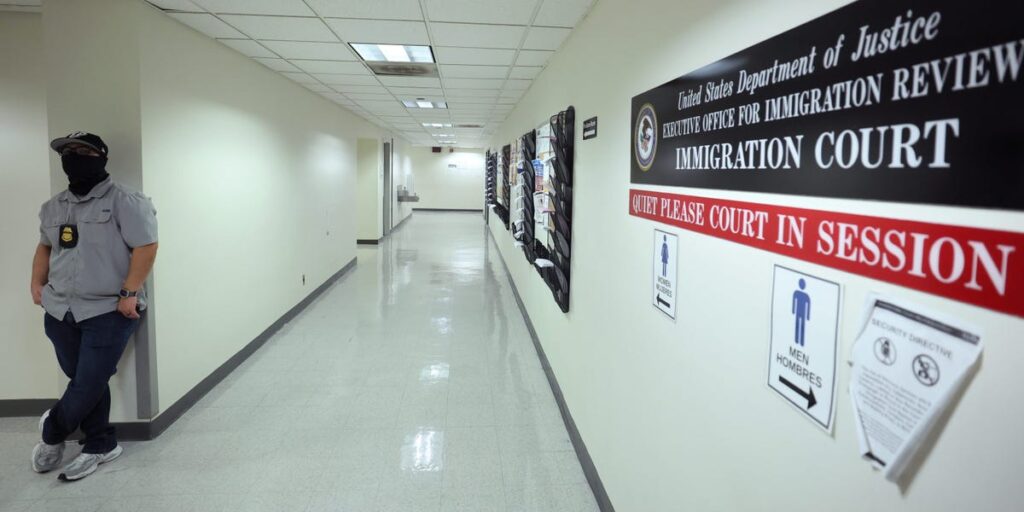We’re learning what America looks like with fewer immigrants and fewer jobs.
The Trump administration has been cracking down on immigration over the past few months, ramping up deportations and travel bans. It recently announced a $100,000 fee for new H-1B visa program applicants, which could affect some major companies, like Amazon, that leverage the program.
Immigration policies could be exacerbating the defining feature of the frozen 2025 labor market: Workers haven’t faced mass layoffs, but hiring has slowed to a crawl. A more slowly-growing labor force with lower levels of immigration will likely see a much lower level of job growth, but weak labor demand with weak supply means that unemployment may not spike. And even native-born workers have not yet seen a major boon to employment in that continuing slow market.
Dante DeAntonio, labor economist at Moody’s Analytics, said there’s “no doubt” immigration policy changes are affecting the job market.
“There was a clear downshift in labor force growth starting in the second half of 2024, and the labor force has flatlined so far in 2025,” DeAntonio said. “The most immediate impact of this change is a likely shortage of available labor, particularly in industries that are more heavily reliant on foreign-born labor, such as agriculture, construction, and leisure/hospitality.”
Abigail Jackson, a spokesperson for the White House, said President Donald Trump aims to grow the US economy and add job opportunities for Americans.
“There is no shortage of American minds and hands to grow our labor force, and President Trump’s agenda to create jobs for American workers represents this Administration’s commitment to capitalizing on that untapped potential while delivering on our mandate to enforce our immigration laws,” Jackson said. “The Trump Administration is focused on protecting the American workforce, ending instances of labor exploitation or trafficking, and working with American employers to ensure they have the legal workforce they need to be successful.”
Below are some of the ways immigration has affected the job market.
We may have to get used to fewer jobs
Declining immigration means a more slowly growing workforce, which could make this summer’s disappointingly low job growth a new normal.
One measure used to assess the labor market’s performance is the breakeven rate, or how much job growth is needed to keep unemployment steady as the labor force adds more new entrants from immigration and young people aging into their working years. A more slowly-growing workforce from lower levels of immigration would make that breakeven rate drop, and that could lead to lower job growth in the long run.
We won’t know the full extent of how the likely decline in immigration has affected population growth for a while, so estimates for how many jobs the US needs to add each month to keep unemployment stable in the long run could vary widely.
Jed Kolko, a senior fellow at the Peterson Institute for International Economics, told Business Insider that if net immigration is zero, it would mean a breakeven rate close to August’s job growth. However, he cautioned that we don’t yet know the full extent of the immigration slowdown. A blog post from Kolko showed that the breakeven rate in early 2024 was much higher.
Other estimates for that breakeven rate are higher. A Morgan Stanley note in early September said that 70,000 jobs added a month by the end of the year is probably consistent with flat unemployment. That would mean recent growth is too low.
On the other end of the spectrum, David Kelly, the chief global strategist at JPMorgan Asset Management, told Business Insider the payroll growth needed to keep unemployment constant could be around zero.
“You’ve got very weak growth at this stage in the economy because we’ve got really no increase in the number of people available to work,” Kelly said.
US-born unemployment has increased
Immigration changes don’t necessarily mean a better job market for non-immigrant job seekers. The native-born unemployment rate has ticked up from January’s rate.
“Some people expected that a slowdown in immigration would open up jobs for native-born workers,” Kolko said.
People are having a hard time getting a job because companies aren’t so eager to hire or lay people off as they deal with economic uncertainty. “Sending immigrant workers away is not going to insulate workers from the labor market impact of tariffs or a recession,” said Chris Martin, the lead researcher at company-review and job-search platform Glassdoor.
Pay is one reason DeAntonio thinks immigration changes would take a while to see a positive effect on non-immigrant job seekers. He said that “non-immigrant labor is not a perfect substitute for immigrant labor because the types of jobs and occupations filled by immigrant labor are lower paying, on average, and many non-immigrants are unlikely to fill those positions unless pay rises substantially.”
The recent H-1B changes could mean employers look to offshore work or check out other visas. “We will likely push to get employees O-1 visas instead now,” one startup founder told Business Insider. A 2023 paper from Britta Glennon, an assistant professor of management at the University of Pennsylvania’s Wharton School, found that US multinational companies that encounter H-1B visa restrictions tend to ramp up hiring in other countries, especially in China, India, and Canada.
Glennon told Business Insider that multinational companies are probably going to ramp up offshore strategies unless they really need talent in the US.
“If they’re intensifying the offshoring, that’s more jobs and investment going abroad, rather than the US,” Glennon told Business Insider, adding that such a development would run counter to the intent of the policy changes to visa programs like H-1B. She added that not all employers, including startups and universities, have the resources or option to offshore.
The construction sector is having a hard time
Some sectors that rely more on immigration are not growing much. Construction employment has plateaued, for instance.
“Immigration policies are definitely impacting labor supply by both pushing out immigrant workers and slowing applications to work in the US,” said Martin. “It’s too early to know just how many, but we are likely talking hundreds of thousands fewer workers.”
Kolko said in a recent analysis that employment growth has been flat in construction, home healthcare, and other industries that are more reliant on unauthorized-immigrant labor, with a three-month annualized increase of just 0.06% in August. Other private sectors together had an increase of 0.34%, which is cooler than the 2.2% at the start of the year, as the job market has softened.
Tim Paradis contributed to this story.
Read the full article here
















